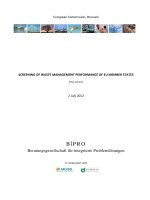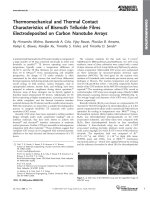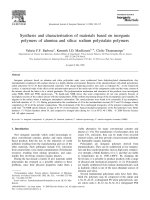Electrochemical performance of Fe2O3-AB based composite electrode
Bạn đang xem bản rút gọn của tài liệu. Xem và tải ngay bản đầy đủ của tài liệu tại đây (683.95 KB, 12 trang )
VNU Journal of Science: Mathematics – Physics, Vol. 35, No. 3 (2019) 88-97
Original Article
Electrochemical Performance of Fe2O3-AB
Based Composite Electrode
Trinh Tuan Anh, Bui Thi Hang*
International Training Institute for Materials Science (ITIMS),
Hanoi University of Science and Technology (HUST), Hanoi, Vietnam
Received 04 May 2019
Revised 29 May 2019; Accepted 01 June 2019
Abstract: To find a suitable material for Fe-air battery anode, Fe2O3 nanoparticles (nm) and
microparticles (µm) were used as active materials and Acetylene Black carbon (AB) as additive to
prepare Fe2O3/AB composites. The effect of grain size of iron oxide particles and additives on the
electrochemical behavior of Fe2O3/AB composite electrodes in alkaline solution have been
investigated using cyclic voltammetry (CV), galvanostatic cycling and electrochemical impedance
spectroscopy (EIS) measurements. Iron oxide nanoparticles provided better cyclability than iron
oxide microparticles. Impedance of electrode increased during cycling but the nm-Fe2O3/AB
electrode gave smaller resistance than µm-Fe2O3/AB one. The additives showed strongly effects on
the electrochemical behaviors of iron oxide electrodes. The AB additive enhanced the electric
conductivity of Fe2O3/AB electrode and thus increased the redox reaction rate of iron oxide while
K2S interacted and broke down the passive layer leading to improved cyclability and giving higher
capacity for Fe2O3/AB electrodes.
Keywords: Fe2O3 nanoparticles, Fe2O3 microparticles, K2S Additive, Fe2O3/AB composite
electrode, Fe-air battery anode.
1. Introduction
High energy density for metal/air batteries has been the focus of attention in recent years for
applications involving electric vehicles [1-3]. Iron is a potential candidate for metal/air battery anode
and is also used in nickel/iron battery because high theoretical energy (0.96 Ah/g) and low cost [4-7,8].
However, the problem of iron electrode is the passive layer of Fe(OH)2 formed during cycling leading
________
Corresponding author.
Email address:
https//doi.org/ 10.25073/2588-1124/vnumap.4348
88
T.T. Anh, B.T. Hang / VNU Journal of Science: Mathematics – Physics, Vol. 35, No. 3 (2019) 88-97
89
to a low utilization coefficient. Further, the potential of the Fe/Fe(OH)2 couple is only slightly more
negative than that of the hydrogen evolution potential in alkaline solution [5,7] thereby there is a
simultaneous evolution of hydrogen during charging [8-9]. This is the cause of the low charge/discharge
efficiency and high self-discharge rate of iron electrode. In order to overcome the limitations of the iron
electrode, a number of additives are incorporated in the iron electrode during fabrication [6, 8-11] or in
electrolyte [6, 10-14] or both [6, 10-11,14]. In order to increase the active material surface area, in the present
study, we prepared Fe2O3/C using Acetylene Black carbon (AB) and iron oxide for use as anode in Fe/air
battery. In addition, K2S is used as an additive to electrolyte to improve the limitations of the iron electrode.
2. Experimental
Fe2O3 nanopartilces (nm-Fe2O3) and microparticles (µm-Fe2O3) (Wako Pure Chemical Co.) and
acetylene black (AB, Denki Kagaku Co. Ltd.) were used as the iron sources and carbon additives to
prepare the Fe2O3/AB materials by mixing of 50 : 50 wt% Fe2O3 and AB followed by ball milling. The
Fe2O3/AB composite electrodes were fabricated by mixing 90 wt% Fe2O3/AB materials obtained after
ball milling with 10 wt% polytetrafluoroethylene (PTFE, Daikin Co.) binder followed by rolling and
punching into the form of a pellet with 1 cm in diameter. Thus, in Fe2O3/AB composite electrodes,
Fe2O3, AB and binder components are 45, 45 and 10 wt%, respectively.
To investigate the effect of Fe2O3 particle size as well as the K2S additive on the electrochemical
properties of the Fe2O3/AB electrodes, cyclic voltammetry (CV) studies have been carried out in threeelectrode glass cells with Fe2O3/AB composite electrode as the working electrode, Pt mesh as the counter
electrode and Hg/HgO as the reference electrode. The electrolyte was 8 mol dm-3 KOH aqueous solution
or 7.99 mol dm-3 KOH + 0.01 mol dm-3 K2S aqueous solution. CV measurements were taken at a scan
rate of 2 mV s−1 and within a voltage range of −1.3 V to −0.1 V. Charge/discharge measurements were
conducted on three-electrode glass cells. In the charge course, the current density of 50 mA cm-2 was
used with a cutoff potential of −1.2 V whereas in the discharge course, a constant current density of 2.0
mA cm-2 was applied with a cutoff potential of −0.1 V. The electrochemical impedance spectroscopy
(EIS) studies have been performed on a three-electrode glass cell assembly using Auto Lab system. The
impedance spectra were recorded after the cell was cycled and stopped at open circuit potential (OCP)
followed by a rest period of 1 hour. The AC perturbation signal has been fixed at 10 mV, and the
frequency range was from 10-2 to 105 Hz in the EIS. In all electrochemical measurements, we used fresh
electrodes without pre-cycling.
3. Results and discussion
Nanoparticles (nm) and microparticles (μm) of Fe2O3 have been used as electrode active materials
to investigate the effect of Fe2O3 particle size on their electrochemical properties. The SEM images of
nm- Fe2O3 and μm-Fe2O3 samples are shown in Figs. 1a and 1b, respectively. The nm-Fe2O3 particles
are less than 100 nm and relatively uniform. They look like little balls. Unlike the nm- Fe2O3 sample,
the SEM image of the μm-Fe2O3 in Fig. 1b shows mixed particle size and shape. They consist of Fe2O3
flat flakes with dimensions ranging from several hundred nanometers to several ten micrometers.
Different size and shape of the nm-Fe2O3 and μm-Fe2O3 samples shall affect the electrochemical
characterization of the Fe2O3 electrode.
3.1. Effect of particle size and shape of iron oxide and additive on the electrochemical behavior of
Fe2O3/AB composite electrode
90
T.T. Anh, B.T. Hang / VNU Journal of Science: Mathematics – Physics, Vol. 35, No. 3 (2019) 88-97
The cyclic voltammetry (CV) measurements of the nm-Fe2O3/AB composite electrode (Fe2O3: AB:
PTFE = 45:45: 10 wt%) are presented in Fig. 2a. On the oxidation scan from −1.3 V to −0.1 V, two
oxidation peaks of Fe/Fe(II)(a1), Fe(II)/Fe(III)(a2) occur at about −0.9 V and −0.4 V, whereas on the
(a)
200 nm
(b)
200 nm
Figure 1. SEM images of (a) nm-Fe2O3 and (b) µm-Fe2O3 samples.
reverse direction, only one reduction peak corresponding to Fe (III)/Fe(II)(c 1) occurs at about −1.0 V
along with the hydrogen evolution peak. The reduction peak of Fe(II)/Fe(c2) is completely masked by
hydrogen evolution. Particularly, the oxidation peak a2 is very large and broad compared to the a1 peak.
This may be due to the formation of Fe(OH)2 which inhibits the oxidation of the inner layer of the iron
leading to increase the overpotential of Fe/Fe(II) reaction. Consequently, a 2 peak includes oxidation
reactions of both Fe/Fe(II) and Fe(II)/Fe(III). This is the reason why a2 is a very large peak compared to
a1 peak. The redox peak currents increases during initial cycles and then decreases upon further cycling.
In the first discharge, Fe(OH)2 was formed on the surface of iron and carbon via an intermediate soluble
species, HFeO2 . The passive layer Fe(OH)2 inhibited the oxidation of inner iron and thus overpotential
increased. In initial cycles, Fe(OH)2 layer was thin, the oxidation reaction rate was high. Further cycling,
insulated Fe(OH)2 layer became thicker resulting in larger electrode resistance and consequently redox
current decreased.
In order to investigate the effect of grain size and morphology of Fe2O3 on the electrochemical
behaviors of Fe2O3/AB electrodes, CV measurements were carried out on the μm-Fe2O3/AB electrode
(Fe2O3: AB: PTFE = 45:45: 10 wt%) and the results are presented in Fig. 3a. Similar to nm-Fe2O3/AB,
the redox peaks a1, a2, c1 also appear at around − 0.9, − 0.5 and −0.95 V respectively, and c2 peak is
T.T. Anh, B.T. Hang / VNU Journal of Science: Mathematics – Physics, Vol. 35, No. 3 (2019) 88-97
91
masked by hydrogen peak. However, the current intensity of these peaks decreases with increasing cycle
number.
Compared to nm-Fe2O3/AB sample (Fig. 2a), the redox peaks of μm-Fe2O3/AB (Fig. 3a) electrode
are very small. This proves that the size and shape of Fe2O3 particles strongly influence their
electrochemical properties. In this case, nm-Fe2O3 particles exhibit better cyclability than μm-Fe2O3.
This could be explained in view of the Fe2O3 nanoparticles having a larger surface area than the Fe2O3
microparticles, so that the redox reaction rate of nm- Fe2O3 is greater than μm-Fe2O3 and therefore it has
better cyclability.
12
Current / mA
8
(a)
a2
4
a1
0
1st
2nd
3rd
4th
5th
-4
c2 c
1
-8
-12
H2
-16
-1.4 -1.2 -1.0 -0.8 -0.6 -0.4 -0.2
0.0
Potential / V vs. Hg/HgO
20
a2
(b)
Current / mA
10
a1
0
-10
c1
-20
c2
-30
-40
H2
1st
2nd
3rd
4th
5th
-1.4 -1.2 -1.0 -0.8 -0.6 -0.4 -0.2 0.0
Potential / V vs. Hg/HgO
Figure 2. CV profiles of nm-Fe2O3 /AB composite electrodes (Fe2O3:AB:PTFE = 45:45:10 wt.%) in (a) KOH and
(b) KOH+K2S electrolyte solution.
92
T.T. Anh, B.T. Hang / VNU Journal of Science: Mathematics – Physics, Vol. 35, No. 3 (2019) 88-97
The role of adding K2S in the electrolyte on the cyclability of the nm-Fe2O3/AB and µm-Fe2O3/AB
electrodes have been investigated and the results are presented in Fig. 2b and 3b respectively. Comparing
the CV results of the nm-Fe2O3/AB sample in KOH solution (Fig. 2a) with those in KOH+K2S solution
(Fig. 2b), it can be seen that adding K2S to the electrolyte solution (2b), beside the appearance a1, a2 and
c1 peaks, the reduction peak of Fe (II)/Fe(c2) is observable and it is separated from the hydrogen
evolution peak. This demonstrates that the amount of hydrogen evolution is partially suppressed and the
reaction rate of Fe/Fe(II) couple is increased while its over-potential is decreased with the presence of
K2S in the electrolyte solution. In other words, the reaction rate of Fe/Fe(II) is increased and its
overpotential is decreased by sulfide ion. There may be an effect of the adsorbed sulfide ion, which
interacts strongly with Fe(I), Fe(II) or Fe(III) in the oxide film and promotes the dissolution of iron and
enhance the bulk conductivity of the electrode, thereby improving cycleability [15-16].
6
3
a2
(a)
a1
Current / mA
0
-3
c2
c1
1st
2nd
3rd
4th
5th
-6
-9
-12
-15
H2
-1.4 -1.2 -1.0 -0.8 -0.6 -0.4 -0.2
0.0
Potential / V vs. Hg/HgO
6
Current / mA
3
(b)
a2
a1
0
-3
c2
-6
-9
c1
H2
-12
1st
2nd
3rd
4th
5th
-15
-1.4 -1.2 -1.0 -0.8 -0.6 -0.4 -0.2
0.0
Potential / V vs. Hg/HgO
Figure 3. CV profiles of µm-Fe2O3 /AB composite electrodes (Fe2O3:AB:PTFE = 45:45:10 wt.%) in (a) KOH
and (b) KOH+K2S electrolyte solution.
T.T. Anh, B.T. Hang / VNU Journal of Science: Mathematics – Physics, Vol. 35, No. 3 (2019) 88-97
93
Further cycling, the current under these peaks decreased and deposition peak of iron c2 is gradually
masked by hydrogen. This suggests that the inner resistance of the electrode was increased due to the
insulating of Fe(OH)2 layer forming during the oxidation. When K2S is present in the electrolyte
solution, initially the reaction rates of the Fe/Fe(II) and Fe(II)/Fe (III) couples are increased, but on
subsequent sweeping, the formed Fe(OH)2 film is thicker, the passivation overwhelms the increase in
the redox reaction rate supported by K2S thereby reducing the redox current. Consequently, K2S additive
proved the positive effects on the electrochemical behaviors of nm-Fe2O3/AB composite electrode.
The CV results of μm-Fe2O3/AB electrode in electrolyte containing S-2 are depicted in Fig. 3b. In
comparison to CV results in KOH electrolyte (Fig.3a), the CV profiles in both cases are relatively
similar. When K2S is introduced into the electrolyte solution (Fig. 3b), the a1, a2, and c1 peaks still appear
at the same potentials as in Figure 3a. As the number of sweeps increases, the current intensity in both
couple peaks decreases. No significant differences are observed in the CV profiles of the μm-Fe2O3/AB
electrodes in KOH and KOH+ K2S. Thus, for the μm-Fe2O3/AB composite sample, the presence of K2S
in the electrolyte does not have a positive effect on the electrochemical behavior of μm-Fe2O3 as well
as the cyclability of the μm-Fe2O3/AB electrode.
3.2. Electrochemical Impedance spectroscopy (EIS) of nm-Fe2O3/AB and µm-Fe2O3/AB composite
electrodes in electrolyte with and without additive
Electrode resistance were determined for nm-Fe2O3/AB và µm-Fe2O3/AB composite electrodes in
KOH and KOH+K2S electrolytes using electrochemical impedance spectroscopy (EIS). The EIS
measurements were carried out before and after five initial cycles at open circuit potential (OCP) and
the results are shown in Figs. 4 and 5 respectively. Before and after cycling, each spectrum consists of
a semicircle in a high frequency region, which was assigned to the interfacial response, followed by a
straight line in the lower frequency region corresponding to Warburg impedance. As the limitation of
the apparatus was 100 Hz, straight line at lower frequencies is either short or not present.
500
(a)
-Z''/Ohm
400
300
200
Before cycle
After 5 cycles
100
0
0
200
400
600
Z'/Ohm
800
1000
94
T.T. Anh, B.T. Hang / VNU Journal of Science: Mathematics – Physics, Vol. 35, No. 3 (2019) 88-97
500
(b)
-Z''/Ohm
400
300
Before cycle
After 5 cycles
200
100
0
0
200
400
600
800
1000
Z'/Ohm
Figure 4. Electrochemical impedance spectroscopy (EIS) of nm-Fe2O3/AB electrode (Fe2O3:AB:PTFE =
45:45:10 wt.%) in (a) KOH and (b) KOH + K2S electrolyte solution
In the case of KOH electrolyte (Figs. 4a and 5a), before cycling, the semicircle was observed with
a straight line in the lower frequency region. After cycling, the semicircle was observable but not
completely and semicircle diameter of the electrode after cycling is larger than that before cycle. This
suggested that the resistance of electrodes increased after cycling and gradually increased with increase
in cycle number. The semicircle diameter of nm-Fe2O3/AB electrode is a little smaller than that of µmFe2O3/AB electrode in KOH suggests that nm-Fe2O3/AB electrode has lower resistance than µmFe2O3/AB. These results are consistent with the CV results (Figs.2 and 3), as the redox current decreased
with repeated cycling and nm-Fe2O3/AB electrodes have better cyclability than µm-Fe2O3/AB. This is
reasonable since resistance of electrode gradually increased with repeated cycling and µm-Fe2O3/AB
electrodes give larger resistance than nm-Fe2O3/AB electrode.
500
Before cycle
After 5 cycles
(a)
-Z''/Ohm
400
300
200
100
0
0
200
400
600
Z'/Ohm
800
1000
T.T. Anh, B.T. Hang / VNU Journal of Science: Mathematics – Physics, Vol. 35, No. 3 (2019) 88-97
95
500
Before cycle
After 5 cycles
(b)
-Z''/Ohm
400
300
200
100
0
0
200
400
600
800
1000
Z'/Ohm
Figure 5. Electrochemical impedance spectroscopy (EIS) of µm-Fe2O3/AB electrode (Fe2O3:AB:PTFE =
45:45:10 wt.%) in (a) KOH and (b) KOH + K2S electrolyte solution
In the case of electrolyte solution containing K2S additive (Fig. 4b and 5b), the semicircle diameters
of the electrodes after cycling are also larger than those of the electrodes before cycle similar to that
observed in KOH solution thereby implying that the electrode resistance also increases during cycling
in additive electrolyte. Remarably, the semicircle diameters of electrodes before and after cycling in the
electrolyte containing K2S (Figs. 4b and 5b) are larger than those in the base electrolyte (Figs. 4a and
5a). These results demonstrate that the resistance of the Fe2O3/AB electrode in the additive electrolyte
is larger than that in the free additive electrolyte and can be ascribed to the S 2- ion in the electrolyte
solution adsorbed on the surface of the Fe2O3/AB electrode causing an increase in the contact resistance
between the electrode surface and the electrolyte solution. However the semicircle diameter of nmFe2O3/AB electrode before cycle is a little smaller than that after cycle while it is much smaller than that
of µm-Fe2O3/AB electrode after cycle. This tendency is consistent with the of CV profiles (Figs. 2b and
3b). In the case of nm-Fe2O3/AB electrode (Fig. 2b), the presence of the K2S additive in the electrolyte
enhances the redox reaction rate of the Fe2O3/AB electrode. Therefore, the presence of S2- in the
electrolyte solution on the one hand increases the resistance of the Fe2O3/AB electrode, but on the other
hand it also enhances the redox reaction rate of the electrode. However, the current intensity still
decreased with increase in cycle number due to the passive layer Fe(OH)2 formed during the discharge.
Adding K2S into the electrolyte solution, initially the reaction rate of the Fe/Fe(II) and Fe(II)/Fe(III)
couples increases, but the Fe(OH)2 layer becomes thicker upon repeated cycling, passivation dominates
the increase in the reaction rate leading to reducing redox current. In the case of µm-Fe2O3/AB electrode,
the presence of the K2S additive in electrolyte did not provide any positive effect either in term of
cyclability of iron (Fig. 3b) nor the impedance of electrode before and after cycling is too large (Fig. 5b)
than that of nm-Fe2O3/AB electrode. Consequently, under these experimental conditions, nm-Fe2O3/AB
electrode provided better cyclability, higher redox reaction rate than µm-Fe2O3/AB electrode.
3.3. Cycle performance of nm-Fe2O3/AB electrode
To obtaine the cycle performance of nm-Fe2O3/AB electrode, the galvanostatic cycle measurement
in KOH + K2S solution was carried out, the results are presented in Figs. 6 and 7.
96
T.T. Anh, B.T. Hang / VNU Journal of Science: Mathematics – Physics, Vol. 35, No. 3 (2019) 88-97
Potential / V vs. Hg/HgO
0.0
-0.2
1
2
3
7
10
-0.4
-0.6
-0.8
-1.0
-1.2
-1.4
-1.6
0
200
400
600
800
Capacity / mAhg
1000
-1
Figure 6. Charge-discharge curves of nm-Fe2O3/AB electrode in KOH + K2S solution
Discharge capacity / mAhg
-1
400
300
200
100
0
0
5
10
15
20
25
30
Cycle number
Figure 7. Discharge capacity of nm-Fe2O3/AB electrode in KOH + K2S solution.
One oxidation plateau was observed at about –0.65 V in the discharge curves (Fig.6) correspondence
to the oxidation reactions of Fe/Fe(II) and Fe(II)/Fe(III). The plateau was shortened when repeated
cycling. These results suggest that the discharge capacity decreased with further cycling. The changing
of discharge capacity of nm-Fe2O3/AB electrode was consistent with that of CV profiles (Fig. 2b).
Fig. 7 show the cycle performance of the nm-Fe2O3/AB electrode in KOH+K2S solution. High
discharge capacity attained at the initial cycle and then gradually decreased with further cycling. These
results demonstrate the capacity retention was low at this cycling condition. To meet the actual
application requirements the capacity retention still need further improvements.
T.T. Anh, B.T. Hang / VNU Journal of Science: Mathematics – Physics, Vol. 35, No. 3 (2019) 88-97
97
4. Conclusion
The size and morphology of iron oxide strongly affected the electrochemical properties of Fe2O3/AB
composite electrodes. Fe2O3 nanoparticles provided higher redox reaction rate and better cyclability than
Fe2O3 microparticles. Besides that, nm-Fe2O3/AB composite electrodes gave smaller resistance than
m-Fe2O3/AB composite electrodes.
The nm-Fe2O3/AB composite electrodes in electrolyte containing K2S additive showed the
improved redox reaction rate of Fe/Fe(II) and Fe(II)/Fe(III) couples and significantly suppressed
hydrogen evolution during cycling whereas m-Fe2O3/AB composite electrodes did not show such
behaviors. It revealed that K2S has positive effects on the electrochemical properties of nm-Fe2O3/AB
composite electrodes but negligibly affect on the m-Fe2O3/AB one.
The resistance of the Fe2O3/AB composite electrodes after cycling is higher than that of before
cycling in both electrolytes containing K2S additive and free additive. The electrochemical impedance
of the Fe2O3/AB electrodes in the electrolyte containing K2S additive increased with respect to that in
the basic KOH electrolyte. The nm-Fe2O3/AB composite electrode in electrolyte containing K2S additive
gave high discharge capacity at initial cycle and then gradually decreased with further cycling.
Acknowledgements
This research is funded by Vietnam National Foundation for Science and Technology Development
(NAFOSTED) under grant number 103.02-2018.04.
References
[1] L. Ojefors, L. Carlsson, An iron - air vehicle battery, J. Power Sources 2 (1977-1978) 287-296.
[2] K.F. Blurtin, A.F. Sammells, Metal/air batteries: Their status and potential - a review, J. Power Sources 4 (1979)
263-279.
[3] A.M. Kannan, A.K. Shukla, Rechargeable Iron/Air cells employing bifunctional oxygen electrodes of oxide
pyrochlores, J. Power Sources 35 (1991) 113-121.
[4] K. Vijayamohanan, T.S. Balasubramanian, A.K. Shukla, Rechargeable alkaline iron electrodes, J. Power Sources
34 (1991) 269-285.
[5] C. Chakkaravarthy, P. Periasamy, S. Jegannathan, K.I. Vasu, The nickel/iron battery, J. Power Sources 35 (1991)
21-35.
[6] M. Jayalakshmi, B.N. Begumi, V.R. Chidambaram, R. Sabapathi, V.S. Muralidharan, Role of activation on the
performance of the iron negative electrode in nickel/iron cells, J. Power Sources 39 (1992) 113-119.
[7] A.K. Shukla, M.K. Ravikumar, T.S. Balasubramanian, Nickel-Iron Storage Batteries, J. Power Sources 51 (1994)
29-36.
[8] C.A. Caldas, M.C. Lopes. I.A. Carlos, The role of FeS and (NH4)2CO3 additives on the pressed type Fe electrode,
J. Power Sources 74 (1998) 108-112.
[9] C.A.C. Souza, I.A. Carlos, M.C. Lopes, G.A. Finazzi, M.R.H. de Almeida., Self-discharge of Fe-Ni alkaline
batteries, J. Power Sources 132 (2004) 288-290.
[10] G.P. Kalaignan, V.S. Muralidharan, K.I. Vasu, Triangular potential sweep voltammetric study of porous iron
electrodes in alkali solutions, J. Appl. Electrochem. 17 (1987) 1083-1092.
[11] K. Micka, Z. Zabransky, Study of iron oxide electrodes in an alkaline electrolyte, J. Power Sources 19 (1987) 315323.
[12] J. Cerny, Voltammetric study of an iron electrode in alkaline electrolytes, J. Power Sources 25 (1989) 111-122.
98
T.T. Anh, B.T. Hang / VNU Journal of Science: Mathematics – Physics, Vol. 35, No. 3 (2019) 88-97
[13] P. Periasamy, B.R. Babu, S.V. Iyer, Cyclic voltammetric studies of porous iron electrodes in alkaline solutions
used for alkaline batteries, J. Power Sources 58 (1996) 35-40.
[14] Bui Thi Hang, Tomonori Watanabe, Minato Egashira, Izumi Watanabe, Shigeto Okada, Jun-ichi Yamaki, The
effect of additives on the electrochemical properties of Fe/C composite for Fe/air battery anode, J. Power Sources
155 (2006) 461-469.
[15] D.W. Shoesmith, P. Taylor, M.G. Bailey, B. Ikeda, Electrochemical behaviour of iron in alkaline solutions,
Electrochim. Acta 23 (1978) 903-916.
[16] G.P. Kalaignan, V.S. Muralidharan, K.I. Vasu, Triangular potential sweep voltammetric study of porous iron
electrodes in alkali solutions, J. Appl. Electrochem. 17 (1987) 1083-1092.
L.D. Thanh / VNU Journal of Science: Mathematics – Physics, Vol. 35, No. 3 (2019) xx-xx
99









